Effective Strategies to Deter Wasps from Your Yard
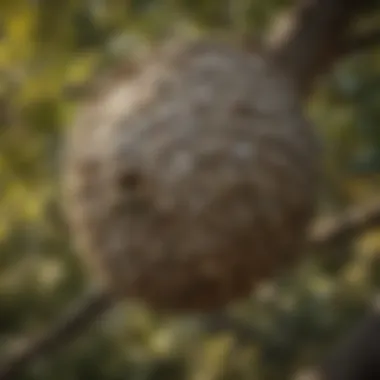
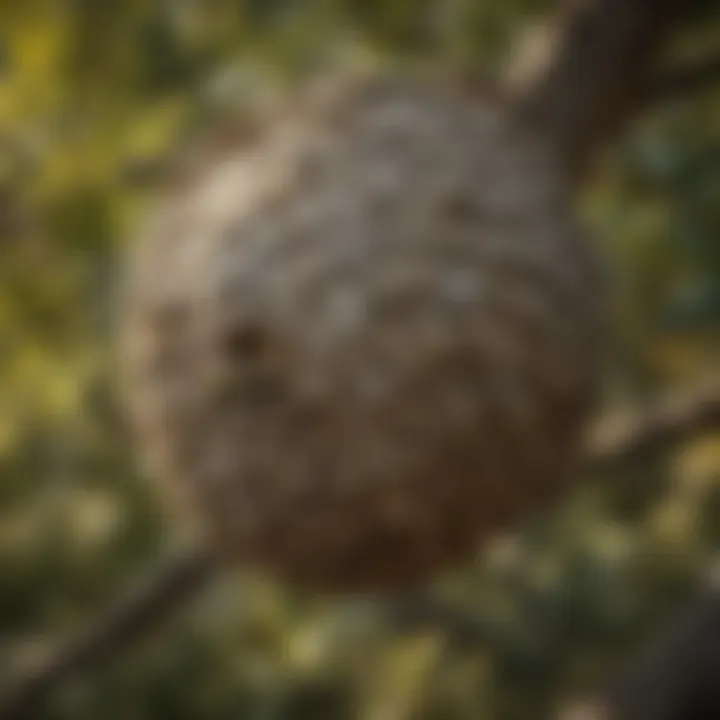
Intro
Wasps can be a nuisance for homeowners and outdoor enthusiasts. Their presence can quickly turn a peaceful afternoon into a stressful ordeal. In order to effectively manage wasps in your yard, it is crucial to understand their biology and behavior. This comprehension forms the foundation of successful deterrent strategies. Homeowners should be proactive, employing methods based on knowledge and awareness rather than reactionary measures.
Understanding the Pest
Identification
Identifying wasps can be key in managing them effectively. Wasps are often recognized by their elongated bodies and distinct coloration, typically yellow and black. Unlike bees, they have a smoother body and are more slender. Some common species to note include the Eastern Yellowjacket and the Paper Wasp. Knowing the species present in your area will help tailor deterrent strategies to address specific nesting behaviors.
Life Cycle
The life cycle of wasps involves four main stages: egg, larva, pupa, and adult. Most wasps start their colonies in late spring. The queen emerges from hibernation, founds a nest, and lays eggs. It is during this nest building phase when preventive measures will be most effective. By late summer, colonies can explode in numbers, making it crucial to address their activity early.
Pest Prevention Strategies
Environment Modification
One of the most effective ways to deter wasps is to modify the environment. Simplifying your yard's appeal to wasps involves:
- Eliminating food sources: Keep food and drinks covered when outdoors.
- Cleaning up spills: Wasps are attracted to sugary substances. Wipe down surfaces after meals or gatherings.
- Securing garbage: Use tightly sealed containers to discourage scavenging.
Physical Barriers
Employing physical barriers can also help prevent wasps from nesting in your yard. Consider:
- Installing screens on porches and patios.
- Using netting around fruit trees or gardens to obstruct access.
These barriers can keep wasps away during the critical periods when they seek nesting sites.
Control Methods
Chemical Control
If wasp populations become unmanageable, chemical control methods may be warranted. Products like insecticidal sprays can effectively eliminate nests. It is important to apply these during the evening when wasps are less active. Always follow label instructions to ensure safety and effectiveness.
Biological Control
For those inclined toward more ecological approaches, biological control options exist. Introducing birds or other beneficial insects that predate on wasps can help keep their numbers in check. Encouraging natural predators can create a balanced ecosystem and reduce reliance on harsh chemicals.
Remember, solutions that are environmentally friendly contribute to better long-term outcomes for the ecosystem.
Epilogue
Managing wasps in your yard involves a blend of understanding their habits, implementing preventive measures, and employing control tactics when necessary. By altering the landscape and habits that attract wasps, homeowners can enjoy their outdoor spaces with much less interference from these pests. Continuous awareness and early intervention are essential to maintaining a peaceful environment.
Understanding Wasp Behavior
Understanding the behavior of wasps is crucial for anyone looking to maintain a peaceful yard. By grasping their habits and preferences, homeowners can take effective steps to prevent wasps from becoming a nuisance. This knowledge not only assists in recognizing signs of wasp presence but also in implementing strategies that deter them systematically.
Wasp Species Overview
There are more than 30,000 species of wasps worldwide. However, only a few types frequently invade residential areas. The common yellow jacket, paper wasp, and hornet are among the most notorious for creating nests in corners of eaves, under decks, or within shrubs. Each species has distinct characteristics that influence its behavior, nesting sites, and food preferences.
The yellow jacket is especially aggressive and is often found scavenging for food in late summer. The paper wasp is less aggressive but still problematic if provoked. Understanding these distinctions helps homeowners to tailor their management strategies appropriately. For instance, yellow jackets are particularly drawn to protein-rich foods, which can influence placement of garbage and outdoor dining areas.
Nesting Habits
Wasp nesting habits vary significantly among species. Most wasps prefer to build nests in sheltered areas, often under eaves, in attics, or within the dense foliage of bushes. They construct nests from chewed wood fibers mixed with saliva, creating a paper-like material. Knowing where these insects might establish nests can assist homeowners in monitoring and removal efforts.
Nests typically start small and grow larger as the colony expands in size. In spring, a queen finds a suitable location and begins making the nest. By summer, the nest can contain thousands of wasps. Thus, early detection is key. Identifying the nests in early stages can be vital for effective removal before they reach peak size and aggression.
Attractive Food Sources
Wasps are opportunistic feeders and are attracted to a variety of food sources. Sweet foods, particularly sugar and fruits, are major attractants. This is especially true during late summer and fall, when food becomes scarce. Additionally, protein-rich foods, such as meats and pet food, draw yellow jackets who are often found near picnics, barbecues, or garbage bins.
To limit wasp activity in your yard, it is essential to secure food sources. Here are some effective strategies:
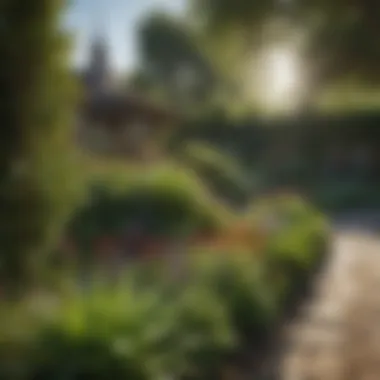

- Keep all food covered during outdoor gatherings.
- Use sealed containers for trash bins.
- Minimize open food left unattended outdoors.
By understanding the factors that attract wasps, you can take measures to deter them successfully.
Identifying Wasp Problems in Your Yard
Understanding how to identify wasp problems in your yard is crucial for effective pest management. Being proactive can prevent larger issues later on. Recognizing the signs and assessing risk levels is key. Homeowners should not take wasp presence lightly, as it may indicate nesting nearby or a significant threat to outdoor activities. Early detection can lead to more effective control strategies, enhancing safety for families and pets.
Signs of Wasp Nests
There are several signs that indicate the presence of wasp nests. Look for these common indicators:
- Visible Nests: Nests may be found in eaves, trees, or shrubs. They are often gray or brown and made from chewed wood fibers.
- Increased Wasp Activity: Observing numerous wasps flying in and out of specific areas often suggests a nest nearby.
- Noise: Some nests can produce a dull buzzing sound due to wasps moving around inside.
- Aggressive Behavior: If wasps behave aggressively when approached, this is usually an indication of a nearby nest.
Identifying these signs early can help in determining the most effective removal strategies, ensuring a safe outdoor environment.
Assessing Risk Levels
Assessing the risk level associated with wasps in your yard is important for deciding on the response. Factors to consider include:
- Location of the Nest: Nests close to high-traffic areas, like patios or playgrounds, present more risk.
- Species Identification: Different species exhibit varying aggression levels. Yellow jackets are more aggressive than hornets, which may influence management strategies.
- Environmental Conditions: Increased food sources, like ripe fruit or open garbage bins, can attract more wasps.
Homeowners should evaluate these aspects to gauge the urgency of intervention. In some situations, it might be best to contact professionals to handle the removal safely, especially if allergic reactions to stings are a concern.
"Proper identification of wasp nests and risk assessment are foundational elements in managing wasp problems effectively."
Engaging with these topics not only protects personal space but also contributes to the overall management of local ecosystems.
Preventive Measures
Preventive measures are a crucial aspect of managing wasps in your yard. By implementing specific strategies, you can significantly reduce the likelihood of attracting these visitors. Not only do these measures curb wasp presence, but they also foster a safer outdoor environment. Finding balance between aesthetics and practicality in yard design can decrease potential wasp attractions effectively.
Securing Food and Trash
One of the main attractants for wasps is food. When food sources are accessible, wasps will likely take advantage. Therefore, securing food items is essential. Ensure that all outdoor dining activities are cleaned promptly. Do not leave uneaten food outside. Store pet food in airtight containers and limit outdoor feeding of pets.
Similarly, garbage bins need special attention. Use bins with tight-fitting lids. Regularly take out the trash, avoiding any accumulation of discarded food items. It is advisable to line trash bins with plastic bags that are also sealed closed when full. This minimizes odors that may draw wasps into the area, thus enhancing the deterrence approach.
Choosing Plant Varieties
The plants you select can impact wasp presence. Certain plants tend to attract wasps due to the nectar they produce. Choosing plant varieties wisely will help to minimize this attraction. Consider opting for non-flowering plants or those that produce less nectar when designing your garden. Xeriscaping or using drought-resistant plants may also be beneficial, as these types of plants are less inviting to wasps.
To further reduce flower diversity in your yard, select flowering plants that naturally repel wasps. Plants such as mint and marigold are known to deter these insects. A well-planned landscape can not only enhance the visual appeal but can also significantly contribute to reduced wasp activity.
Regular Yard Maintenance
Regular maintenance of your yard is vital in minimizing wasp habitats. Regular yard maintenance involves routine inspections and clean-up efforts. Check for hidden nests, especially in sheds, trees, or under eaves. Removing potential nesting sites can deter wasps from making their home in your yard.
Additionally, maintaining your garden helps with attracting fewer pests. Ensure that your yard does not become an overgrown jungle, which can serve as a refuge for wasps. Trim down bushes and trees regularly, and avoid leaving any standing water since stagnation can be appealing to wasps looking for hydration. By actively managing your space, you can create an environment less inviting to these unwelcome guests.
Effective preventive measures create an ecosystem that discourages wasps while promoting beneficial fauna.
Natural Deterrents
Natural deterrents play a significant role in managing wasp populations around your yard. These methods focus on using non-toxic and environmentally friendly options to keep wasps at bay. Utilizing natural deterrents can effectively reduce the likelihood of wasp infestations while maintaining ecological balance. Homeowners may find these strategies beneficial, particularly when aiming for a sustainable approach to pest control.
Essential Oils and Their Effectiveness
Essential oils can serve as effective wasp deterrents. Oils such as peppermint, clove, and lemongrass are known for their strong aromas, which can disrupt the wasp's ability to sense food sources. When properly utilized, these oils can help create a wasp-free zone in your garden.
To apply essential oils, you can create a simple spray solution:
- Mix 10-15 drops of your chosen oil with water in a spray bottle.
- Add a few drops of dish soap to enhance sticking power.
- Shake well and spray around areas where wasps are often seen.
Regular applications may be necessary, especially after rain, to maintain effectiveness. However, always ensure that the solution does not harm beneficial insects in the area.
Plant-Based Repellents


Certain plants naturally repel wasps. Incorporating these plants into your landscaping can create an unwelcoming environment for these pests. For example, planting marigolds, wormwood, and basil can help keep wasps away due to their strong scents.
- Marigolds: Their bright flowers not only beautify your yard but also deter various insects, including wasps.
- Wormwood: This plant has a strong odor that many insects, including wasps, find unpleasant.
- Basil: This culinary herb works double duty by keeping wasps away and adding flavor to your dishes.
When planting these varieties, consider creating a barrier around your garden area. This strategy enhances the protective effects of the plants and contributes to a vibrant yard.
The Role of Beneficial Insects
Beneficial insects, such as ladybugs and certain species of wasps, can help control pest populations without harming your garden's environment. Encouraging the presence of these insects can provide a natural balance, reducing reliance on harmful pesticides.
To attract beneficial insects:
- Provide Diverse Plantings: This offers food and shelter for beneficial species.
- Avoid Pesticides: Many pesticides harm beneficial insects as well as pests, disrupting the natural cycle.
- Create a Habitat: Leaving certain areas of your yard undisturbed can serve as a sanctuary for beneficial insects.
By fostering a diverse ecosystem, you set up a natural deterrent against wasps and other pests, promoting long-term health for your yard.
Chemical Control Options
Chemical control options are pivotal in managing wasp populations effectively. When other preventive measures prove insufficient or when nests are established near human activity, these options can provide swift results. However, responsible application is crucial. Understanding the implications of the chemicals used, their potential environmental impact, and safety precautions for humans and pets is essential for homeowners. The use of chemicals should always be part of a broader strategy that includes preventive measures and monitoring.
Understanding Chemical Barriers
Chemical barriers involve using substances that repel wasps or inhibit their nesting behavior. These treatments create a protective zone around your living spaces. Products containing pyrethroids or neonicotinoids can be effective but require careful handling. Homeowners must ensure these chemicals do not drift into gardens or areas where beneficial insects, like bees, reside. For best results, barriers should be applied in early spring before wasps begin to nest.
- Key Points about Chemical Barriers:
- Timely Application: Essential during the early nesting phase.
- Precision Targeting: Focus on areas with high nest potential, such as eaves and attics.
- Environmental Considerations: Avoid contact with non-target species.
Insecticidal Sprays
Insecticidal sprays specifically target wasps and offer rapid action against visible nests. These products generally include active ingredients that are toxic to wasps but less hazardous to humans when used according to label directions. Sprays should be applied during dusk when wasp activity is lower, reducing the risk of stings.
When using insecticidal sprays, it’s essential to:
- Stand at a safe distance: Follow the manufacturer’s recommendations for distance to avoid getting too close to the nest.
- Wear protective gear: Use gloves, masks, and long sleeves to protect against accidental exposure.
- Follow instructions precisely: Mixing and dosing should adhere strictly to the guidelines provided on the product label.
Baits and Traps
Baits and traps serve as an indirect chemical control method. They attract wasps to a poisoned food source, effectively reducing the population near your home. These traps can be useful throughout the summer when wasp activity peaks. Select baits that are specifically designed for wasps as they are less likely to attract beneficial bees.
- Effective Baiting Tips:
- Location Matters: Place traps away from areas where people dine or congregate.
- Regular Inspection: Check traps frequently and dispose of dead wasps to prevent odor and attractants.
- Seasonal Adjustment: Change bait types as fruit and sources of protein shift in availability during the summer.
"Using chemical control options should not be a homeowner's only strategy but part of a comprehensive approach to wasp management."
When considering these options, always balance effectiveness with safety and environmental health. Remember, the goal is to create a harmonious living space free from wasps while preserving beneficial ecosystems.
Monitoring Techniques
Monitoring techniques are vital in the strategy to deter wasps from residential yards. By observing wasp behaviors and understanding their activity patterns, homeowners can take timely actions to prevent them from becoming a nuisance. Effective monitoring can help identify potential nesting sites before the problem escalates, saving you time and effort in the long run.
Homeowners should consider various elements when establishing a monitoring system. Firstly, regular inspections around the yard for visible wasp activity is crucial. Look for signs of wasps, especially near food sources or potential nesting areas, particularly from spring through late summer.
Surveillance of Wasp Activity
Surveillance of wasp activity involves systematically tracking and assessing wasp populations in your yard. This can be done through visual inspections or even keeping a simple log of sightings. Pay attention to
- Time of Day: Wasps are often seen during warm parts of the day.
- Food Sources: Notice if they are attracted to open trash bins, pet food, or outdoor dining setups.
- Nest Location: Look near tree branches, under eaves, or within shrubs.
Keeping a detailed log can assist in witnessing patterns over time. A map of sightings may assist in identifying high-activity zones in your yard, allowing for targeted preventive measures. Consistent monitoring allows you to notice changes in their behavior, which can indicate the development of nests.
Utilizing Technology for Detection
In today’s digital world, technology offers innovative ways to monitor wasp activity. Technology can elevate your efforts in keeping your yard wasp-free. Tools such as motion-activated cameras can provide insights into wasp movements and nesting points. Additionally, smartphone applications can help keep track of nest sightings and even alert you to peak activity times.
Here are some technologies that can be useful:
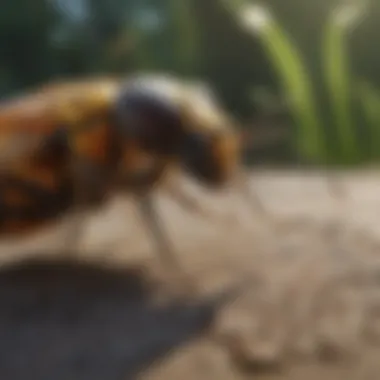
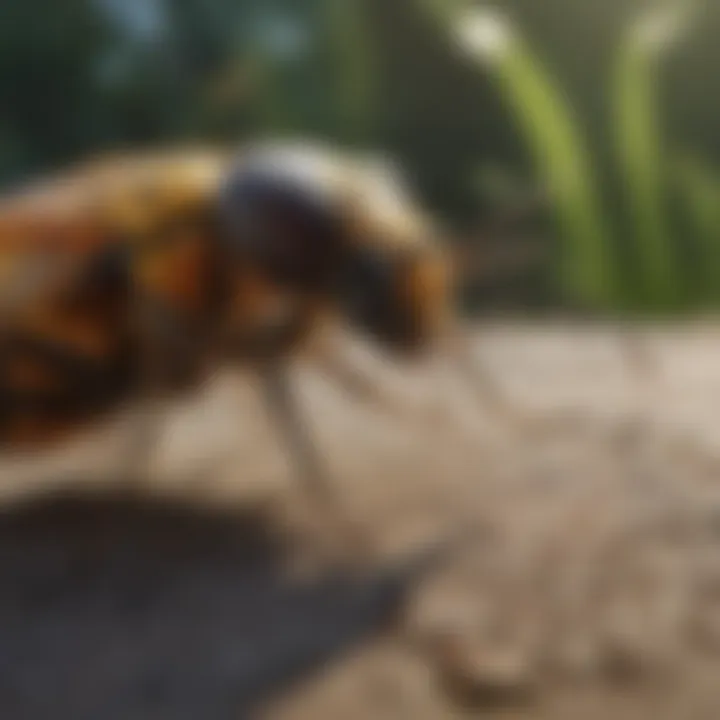
- Mobile Apps: Apps that specialize in pest control may offer tracking features.
- Cameras: Setting up cameras at strategic locations can provide real-time feedback.
- Sensors: Advanced sensors can detect wasp presence in specific areas.
Implementing these modern solutions can enhance your capacity to monitor effectively. Overall, a combination of traditional surveillance with modern technology can create a dynamic approach to wasp monitoring.
The Importance of Professional Help
When it comes to managing wasp populations around your home, the role of professional pest control services cannot be overlooked. Various reasons underline this importance, especially for homeowners who may feel overwhelmed or uncertain about handling these pests safely and effectively.
One primary advantage of engaging professionals is their expertise. Pest control specialists possess extensive knowledge about different wasp species, their behavior, and nesting habits. They can easily identify wasp hotspots and assess the degree of infestation in your yard. Their experience safeguards against the potential mishaps that can arise from DIY attempts, which may exacerbate the problem or even lead to dangerous situations.
Furthermore, professional pest control services often utilize specialized equipment and insecticides that are more effective than common household remedies. They can target nests discreetly and apply treatments that minimize risks to the surrounding environment. This attention to detail assists in not only removing wasps but also in preventing their return.
Another crucial aspect is safety. Wasps can be aggressive when threatened, increasing the likelihood of stings. For individuals who are allergic or have sensitivities to insect venom, the risk can be severe. Professionals are trained to handle such situations with caution, ensuring that both the workers and homeowners are protected throughout the process.
A question that often arises is when to call for professional help. Several signs can indicate that it is time to seek assistance:
When to Call a Pest Control Service
- Visible Nests: If you notice nests in or around your home, it is advisable to contact a professional. Locations like eaves, attics, or the ground near your patio are common nesting spots.
- Increased Wasp Activity: A sudden rise in wasp activity in your yard may suggest a nearby nest. This could become a safety concern if not addressed.
- Recurring Infestations: If wasp problems persist despite your deterrent efforts, professionals can reassess the situation and implement more effective strategies.
- Allergies to Stings: If anyone in your household has a known allergy to wasp stings, immediate professional assistance can prevent life-threatening reactions.
Choosing the Right Pest Control Methods
Not all pest control methods are created equally, and selecting the proper approach is crucial. When you decide to engage a professional, consider the following points:
- Eco-Friendly Options: Emphasizing sustainable practices is valid in today’s pest control landscape. Inquire about chemical-free methods or organic treatments that lessen environmental impact while still effectively addressing the issue.
- Integrated Pest Management (IPM): This strategy focuses on a comprehensive approach. IPM includes not just elimination but also prevention by modifying the environment. Professionals trained in IPM can provide solutions tailored to your specific living space and needs.
- Reputable Service Providers: Not all pest control companies are alike. Research their credentials, customer feedback, and methods used. Choose a service with proven experience in wasp management.
Long-Term Management Strategies
Long-term management strategies are crucial in creating a lasting solution against wasps in your yard. Unlike short-lived measures, these strategies focus on sustainable practices that encourage a healthy ecosystem while effectively deterring wasps. The benefits of this approach include reducing reliance on chemical pesticides, promoting biodiversity, and establishing an outdoor environment less attractive to these insects.
Creating an Eco-Friendly Environment
To create an eco-friendly environment, homeowners can focus on several key factors. Firstly, using native plants in landscaping can significantly help. Native plants require less maintenance and are less prone to pests, which means fewer chemicals are needed. Additionally, native flora supports local wildlife, including beneficial insects that can help control wasp populations naturally.
Another important element is the removal of pest habitats. Keeping your yard clean and organized discourages wasps from establishing nests. Remove any debris, such as old tree stumps or fallen branches, that might attract these insects. You should also regularly check for potential nesting sites and remove them before they become a problem.
Moreover, providing water sources, like bird baths, can attract birds that feed on wasps. This natural predator-prey relationship can help manage wasp populations effectively without resorting to harmful chemicals.
Incorporating Sustainable Practices
Incorporating sustainable practices further enhances the long-term management of wasps. One effective method is composting. Composting not only reduces waste but also creates a habitat for various organisms that can compete with wasps for resources. This natural competition helps in keeping their numbers in check.
Using organic gardening methods is another approach. This includes limiting the use of synthetic fertilizers and pesticides, opting instead for natural alternatives that are environmentally friendly. Products derived from neem oil or insecticidal soap can be effective against pests without harming beneficial insects.
Moreover, fostering community involvement can enhance effectiveness. When neighbors collaborate on pest management, they can share knowledge and resources, establishing a more extensive barrier against wasps. Community education programs can be instrumental in raising awareness about prevention techniques and the benefits of working together to maintain a healthy environment.
"A well-maintained yard not only deters wasps but promotes overall ecological balance."
By focusing on eco-friendly environments and sustainable practices, homeowners can develop a strategic approach that not only addresses the immediate concerns of wasp presence but also contributes to a healthier landscape in the long run.
Community Involvement
Community involvement plays a significant role in effective wasp management strategies. When homeowners collaborate as a collective, they increase their chances of successfully deterring wasps from their neighborhoods. This shared commitment can lead to more effective preventative measures and creates a supportive network among residents. The benefits are multi-faceted, impacting not only personal yards but also the larger ecosystem.
Effective wasp management often requires the cooperation of multiple households. Educated communities can effectively tackle wasp issues, especially since these pests do not respect property boundaries. By exchanging information and strategies, neighbors can collectively reduce attractive environments for wasps. This group approach creates a sense of community responsibility, which is essential for long-term solutions.
Additionally, engaging in community efforts raises awareness of wasp behaviors and the importance of eco-friendly practices. Understanding that local ecosystems are interdependent fosters a more mindful attitude towards pest management. Every homeowner plays a role in keeping their yards pest-free, contributing to the overall welfare of the community.
In summary, community involvement is crucial for sustaining effective wasp deterrent strategies. A collective effort not only improves individual yards but creates a safer and more attractive environment for everyone. Sharing knowledge and resources allows each home to benefit from best practices.
Educating Neighbors on Wasp Management
Educating neighbors on wasp management is a key aspect of creating a wasp-free yard. Knowledge is power, and when individuals understand the habits and preferences of wasps, they can effectively implement prevention strategies. Workshops and informal gatherings can serve as platforms for sharing tips and resources related to wasp deterrence.
Homeowners should discuss various topics, including the importance of removing food sources and the types of plants that may attract or repel wasps. Sharing personal experiences can also enrich conversations. Many have faced similar challenges and can offer insights based on their trials with wasps. Digital forums, such as Facebook groups, facilitate ongoing dialogue and enable homeowners to share real-time strategies.
By fostering an environment of shared learning, neighbors enhance their understanding and become more proactive in implementing strategies. This education creates a sense of responsibility to not only maintain their personal spaces but also contribute to community well-being.
Participating in Local Environmental Efforts
Participating in local environmental efforts is another effective way for homeowners to combat wasps. These initiatives often focus on sustainability and can address a variety of ecological challenges, including pest management. Getting involved with local garden clubs, parks, or environmental organizations allows residents to advocate for practices that deter pests more effectively.
For instance, communities can organize clean-up events to eliminate debris where wasps might establish nests. These activities not only beautify neighborhoods but also reduce the potential for insect breeding grounds. Moreover, local efforts often include the planting of native plants that can support beneficial insects, further minimizing the attraction for wasps.
Taking an active role in environmental committees can lead to comprehensive strategies. Residents can collaborate with experts to implement policies that promote healthy ecosystems and discourage pest infiltration. This engagement empowers homeowners and strengthens community bonds. Through shared responsibility and action toward environmental wellness, wasps can be deterred effectively, resulting in a healthier backyard for all.







